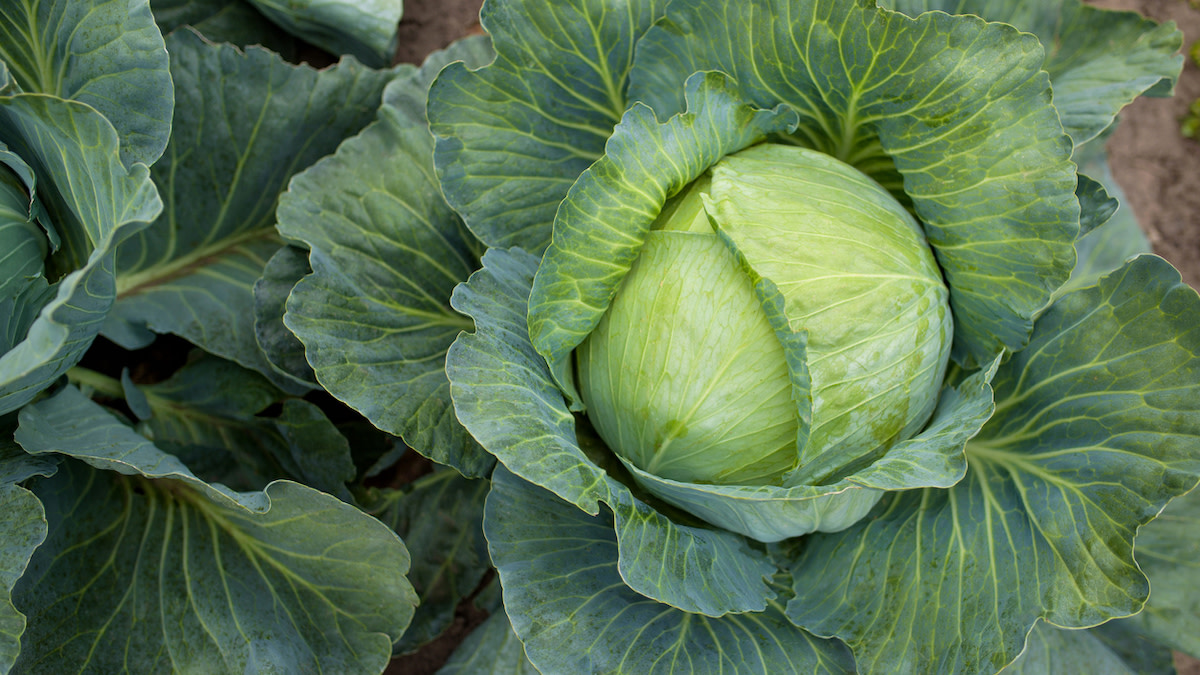
If you read our previous two articles about growing broccoli and brussels sprouts you might be wondering if all green vegetables are actually the same species: Brassica oleracea. They aren't, but not far off. This week’s growing guide covers yet another rendition of that species: cabbage. In the case of cabbage, wild Brassica oleracea was bred to exaggerate one large, densely-packed cluster of thick leaves which we refer to as a head.
Cabbage has been a mainstay of European and the Middle Eastern cultures for centuries, forming the base of the quintessential German sauerkraut, Syrian cabbage rolls, and more. In the U.S., store-bought cabbage is often fairly bland-tasting. The two main reasons for that dilution of flavor are that commercial cabbage varieties are bred for storage and shipping capabilities. Additionally, much of that cabbage is grown in mild California weather. Like other brassicas, cabbage becomes sweeter and more flavorful after experiencing a couple frosty nights. That's something you can only ensure by growing it yourself and choosing more flavorful heirloom varieties.
If you're hesitant to grow cabbage in your vegetable garden, I would encourage you to grow at least one or two plants just to experience that homegrown taste. In my opinion, garden cabbage is so flavorful that it can be eaten right off the plant. Once you taste it, I expect you’ll make a little more room for it in the garden beds the following season.
Starting from Seed Similar to other plants in the cabbage family, it’s important to give your cabbage a head start by starting it from seed indoors before transplanting it into your garden beds. Ideally, your cabbage seedlings will have two or three “true leaves” before being hardened off and transplanted. Cabbage seedlings take between four to six weeks to achieve this size. So, in order for them to be ready to transplant, you should start your seeds indoors about six to eight weeks before your average last-frost date. If you don’t have a suitable space to start seedlings indoors, you can purchase them from most garden centers.
Growing Conditions Cabbage is hardy so it can withstand fairly cold temperatures. Generally, you should feel confident transplanting cabbage into garden beds around two or three weeks before your average last frost date. In order to give the cabbage roots room to grow and the heads room to expand, you should space your cabbage plants 12 to 24 inches apart. If you’re growing a compact cabbage variety bred for smaller heads, you can probably get away with squeezing them a little closer together.
In order to form proper heads, cabbage requires full sun–at least six hours of direct sunlight per day–well-drained garden beds, and a healthy mix of nutrient-rich soil. Incorporating compost into your garden beds will help with draining and ensure a good nutrient mix.
Cabbage Pests and Disease As the names imply, cabbage is the target crop for a number of common garden pests like cabbage loopers, cabbage whites, and cabbage aphids. Cabbage loopers and cabbage whites are both butterflies whose larvae feed on brassica leaves. The most effective way to stop them from harming your cabbage crop is to use floating row covers that prevent the butterflies from laying their eggs on your plants in the first place. They can also be picked off by hand or sprayed with the organic pesticide Bacillus thuringiensis (BT).
Cabbage aphids are generally more of a cosmetic problem, but if their population gets out of control they can decrease the health of your plants by sucking sap and spreading plant diseases. The best control for aphids is to either physically spray them off of the plants with a hard stream of water or spray them with insecticidal soap.
Small mammals like rabbits and groundhogs can be a major problem in a cabbage patch, but they can be effectively controlled using small chicken wire fences. On our homestead, we have also found that groundhogs make a delicious entrée. So, if your fences aren't working, adding some gopher to the dinner plate is another option.
Cabbage Harvest and Storage Depending on the variety you choose to grow, your cabbage will be ready to harvest anywhere from 60 to 100 days from planting. Early maturing varieties are generally smaller and better for fresh eating, while the later maturing varieties typically have larger heads and a longer shelf life. When your cabbage starts to “head up” it will begin with a small, tight cluster in the center of the plant and expand outward. It’s up to your discretion when you want to harvest the head, but if it starts to open or crack you may have let it grow a little too long.
Storage varieties of cabbage can last in a refrigerator or root cellar for weeks and months, but the best way to preserve cabbage long term is to look to the tool of our ancestors: fermentation. All over the world people have been fermenting cabbage for generations, from sauerkraut in Germany to kimchi in Korea to curtido in El Salvador. We like to experiment with all three of these on our homestead and incorporate other homegrown vegetables and herbs to enhance the flavor.
If you haven’t grown it before, I highly recommend dedicating some space in your vegetable garden to cabbage this spring or fall. It’s an incredible feeling of accomplishment to pull a hefty cabbage head out of our garden bed. I promise you that nothing goes better with a venison roast than homegrown sauerkraut and new potatoes.







